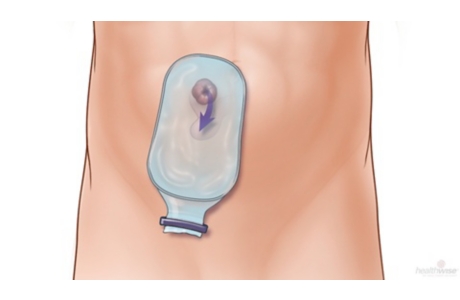Bowel Resection for Colorectal Cancer
Surgery Overview
Resection is another name for any surgery that removes tissue or part of an organ. Bowel resection for colorectal cancer, also called partial colectomy, removes the tumor. To make sure that only healthy tissue is left, the doctor removes a small amount of healthy colon or rectum tissue on both sides of the tumor.
The goal of bowel resection is to take out the part of the colon or rectum where the cancer is. Nearby lymph nodes are taken out and tested for cancer. Then healthy parts of the colon or rectum are sewn back together. Bowel resection is done either by opening the abdomen (open resection) or by laparoscopy.
How It Is Done
Anatomy of the colon and rectum
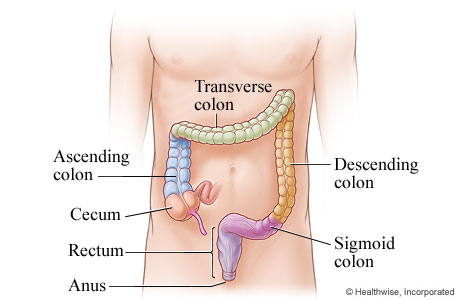
The colon and rectum are the last parts of the bowel (intestine). The bowel extends from the opening where food leaves the stomach to the opening where feces leave the body (anus). The bowel helps to process food, absorb nutrients and water, and get rid of waste.
Colon cancer site

Cancer is shown in a section of the descending colon.
Bowel section removed
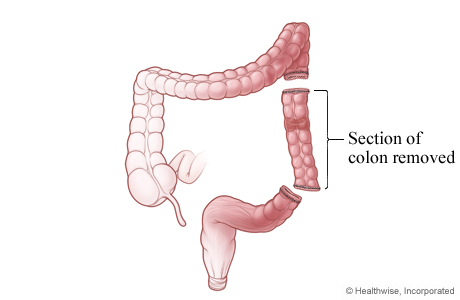
Resection is another name for any surgery that removes tissue or part of an organ. Bowel resection, also called partial colectomy, for colorectal cancer removes the tumor and part of the colon or rectum around the tumor. Both ends of the bowel section being removed are stapled and cut. Nearby lymph nodes, lymph drainage channels, and blood vessels are also removed.
Bowel reattached
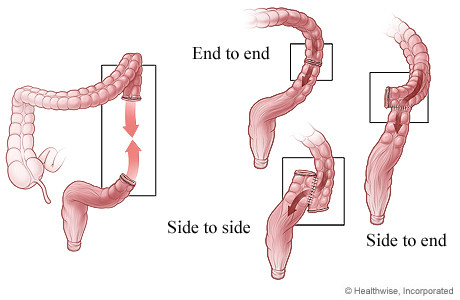
The remaining ends of the bowel are reattached, either end-to-end, side-to-side, or side-to-end.
Surgery scars
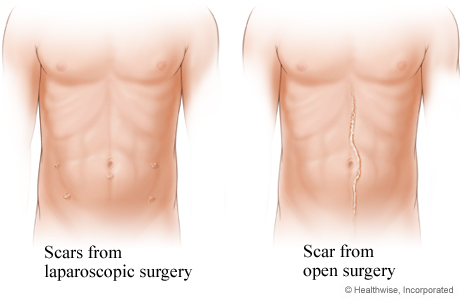
If you have laparoscopic surgery, you will have 3 to 6 small scars. An example is in the picture on the left. Your surgeon may make 1 or 2 of the small openings a little bigger to allow space to complete the surgery. If so, those scars will be a little longer than the others. If you have an open resection, you will have one long scar. An example is in the picture on the right.
What To Expect
Bowel resection requires general anesthesia. You may stay in the hospital for 4 to 7 days or as long as 2 weeks after surgery.
Sometimes the two parts of the colon or rectum can't be reattached, so the surgeon performs a colostomy. This creates an opening, called a stoma, on the outside of the body for the stool, or feces, to pass through into a colostomy bag. Usually the colostomy is temporary, until the colon or rectum heals. If the lower part of the rectum has been removed, the colostomy is permanent.
When the two-stage surgery is done, the time between surgeries is usually 6 to 12 weeks.
The recovery time after each surgery is usually 6 to 8 weeks.
Why It Is Done
In early-stage cancer, surgery is done to remove all the cancer to give the greatest chance of a cure.
In cases of advanced colorectal cancer that has spread (metastasized) to other parts of the body, bowel resection is often done to remove tumors that are blocking the intestine or causing bleeding.
How Well It Works
Most people who have surgery for invasive cancer do not have the tumor return. The likelihood of success depends on many factors, such as the stage of the cancer.footnote 1
If a colostomy is needed during the bowel resection, usually it is temporary, until the colon or rectum heals. If the lower part of the rectum has been removed, the colostomy is permanent.
Risks
All surgeries have some risks of infection, severe bleeding, or complications from general anesthesia.
Possible problems after a bowel resection include:
- Scar tissue (adhesions).
- A leak between the joined sections of the colon.
- Injury to the bladder, ureters, or blood vessels.
Credits
Current as of: October 19, 2023
Author: Healthwise Staff
Clinical Review Board
All Healthwise education is reviewed by a team that includes physicians, nurses, advanced practitioners, registered dieticians, and other healthcare professionals.
Current as of: October 19, 2023
Author: Healthwise Staff
Clinical Review Board
All Healthwise education is reviewed by a team that includes physicians, nurses, advanced practitioners, registered dieticians, and other healthcare professionals.
This information does not replace the advice of a doctor. Healthwise, Incorporated, disclaims any warranty or liability for your use of this information. Your use of this information means that you agree to the Terms of Use. Learn how we develop our content.



